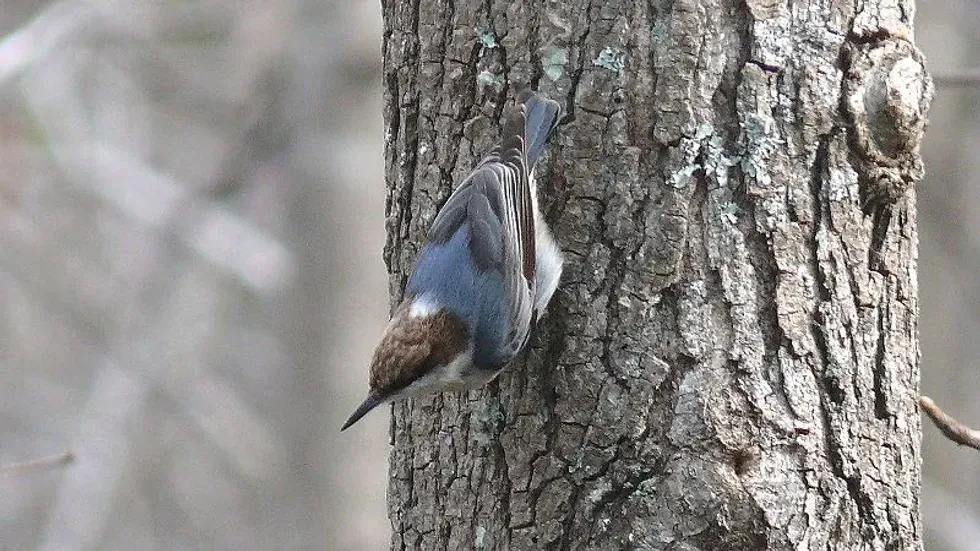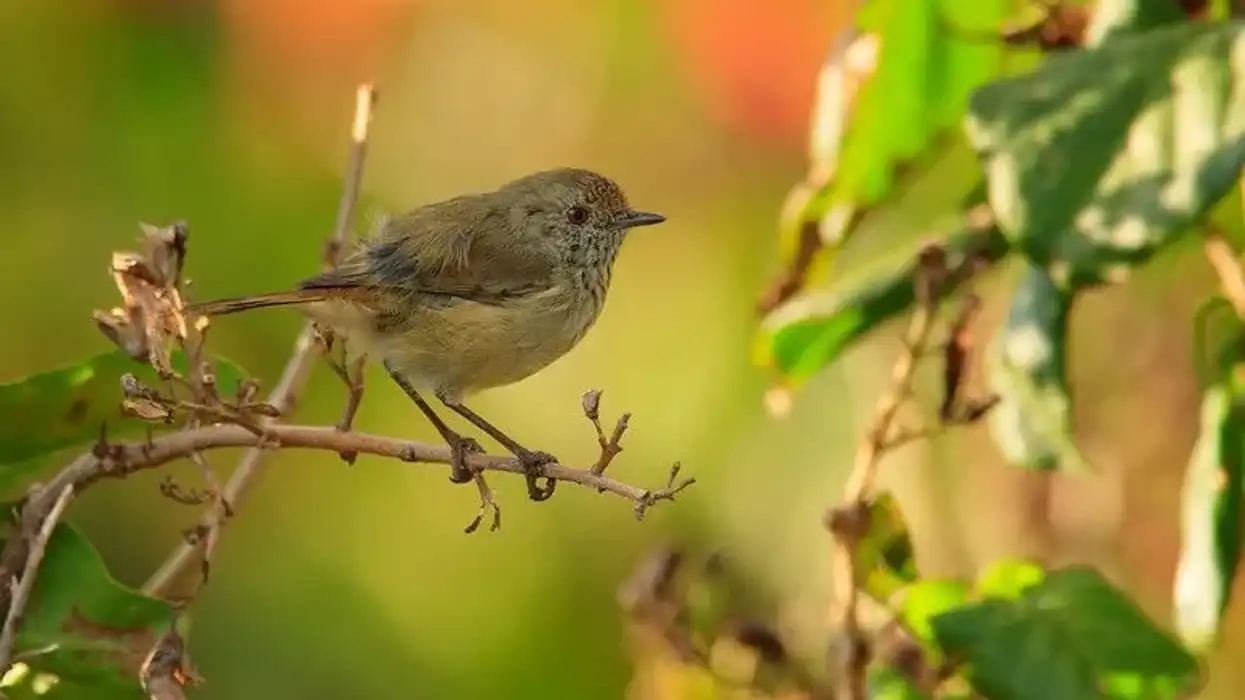If reading about various species of birds excites you, then this is the right place to be. The blog below talks about brown-headed nuthatches. Brown-headed nuthatches are non-migratory songbirds that prefer staying at the same habitat range, i.e., they avoid migrating in groups from season to season. These birds are social and prefer living in groups.
Their small size, accompanied by a beautiful voice, makes them stand out. Moreover, the beautiful splash of brown shade on their head makes them look like birds with a crown - indeed a sight of beauty.
These birds are known to inhabit pine trees more than any other tree. Continue reading further for more fun facts about the brown-headed nuthatch.
If you like reading this, then you must also give a read to Bee Hummingbird and frigate fact pages.
Brown-Headed Nuthatch Interesting Facts
What type of animal is a brown-headed nuthatch?
The brown-headed nuthatch (Sitta pusilla) is a variety of small non-migratory, insect-feeding songbirds residing on pine trees in groups in the United States.
What class of animal does a brown-headed nuthatch belong to?
The brown-headed nuthatch (Sitta pusilla) belongs to the Aves class (birds) of the Animalia kingdom.
How many brown-headed nuthatches are there in the world?
There are four species of brown-headed nuthatch found in great numbers in Canada and the United States; however, the exact number of brown-headed nuthatch (Sitta pusilla) birds around the world is still unknown. According to the IUCN (International Union for the Conservation of Nature), their conservation status is marked as Least Concern.
Where does a brown-headed nuthatch live?
The brown-headed nuthatch (Sitta pusilla) is a non-migratory bird and can be found in abundance in the United States, Canada, Delmarva Peninsula, Texas (west), Bahamas, Florida (South), and Arkansas (west). These North American birds don't really prefer migrating during the transition of weather from summers to winters.
They are also not rare in the UK. They are located across Wales and England, but not in Ireland. They are increasingly prevalent in Scotland.
What is a brown-headed nuthatch's habitat?
Do you want to know about the brown-headed nuthatch bird's habitat range? The brown-headed nuthatch is a non-migratory bird.
Its habitat range is spread across southeastern pine forests with mature pine trees, full of tree trunks or holes or pieces of bark (barks of trees), which helps it hunt better for food. It finds insects hidden beneath the holes or pieces of bark. The holes or the piece of bark, in turn, helps in catching insects as food.
The pine tree trunks help this bird maintain a better grip and hence search for food. Talking about countries, this species of bird can be easily spotted in the United States of America.
Who do brown-headed nuthatches live with?
Brown-headed nuthatches species of birds (North American birds) are social birds and prefer living in groups. During their breeding season, this particular species of birds is known to display a pal-ship behavior, i.e.
the fellow birds, along with the male counterpart, move around the tree with the nest (with eggs) to protect the eggs. They also help in the nesting process, along with fetching and providing food.
How long do brown-headed nuthatches live?
The average lifespan of brown-headed nuthatches (family - Sittidae) in the wild is known to be approximately two to three years. However, the longest lifespan recorded for brown-headed nuthatches is known to be approximately 9-10 years.
How do they reproduce?
Brown-headed nuthatches (North American birds) are known to display a peculiar pattern of breeding and nesting; however, very little is known about their breeding process. These birds are known to choose a partner (male/female bird) for breeding which usually remains the same, be it for a particular season or for a lifetime.
The very first important step in this breeding process is finding a partner. Once an appropriate partner (female and male) is found, they move further together to build a nest.
The male chooses one particular tree where both the male and the female take turns and chip away a hole. The hole or the cavity further created is used as the nest.
It is a well-known fact that these birds (males and females) form several nests before settling own for one particular nest. Later, the female lays about three to nine eggs in the same nest.
This particular species of bird is known to believe in co-parenting. The male and a few other fellow birds take care of the nesting process, the female, and the eggs.
They protect the eggs from being eaten away by predators. The eggs are cream in color with reddish dots and have a nesting period of 18-19 days.
After the eggs hatch within 19 days, the infants are taken care of. The longest lifespan of brown-headed nuthatches is known to be nine years.
What is their conservation status?
The conservation status of this particular species of bird is marked as Least Concern by the IUCN (International Union for the Conservation of Nature). The range of these birds includes southeastern pine forests with mature pine trees full of the tree trunk or piece of bark.
Brown-Headed Nuthatch Fun Facts
What do brown-headed nuthatches look like?
Brown-headed nuthatches are non-migratory small songbirds. They are smaller than a tufted titmouse with a length of 4.3 in (11 cm) and a weight of 0.3 oz (8.5 g) only.
These birds are known to be quite small, which as a matter of fact, makes them even more adorable. Moving further talking about their body fur, the body fur of these birds displays a beautiful splash of colors, beautifully arranged in an aesthetic manner.
The head of these brown-headed nuthatches is dipped in light brown color, which further merges into the gray shaded back and wings.
On the frontier end, a smooth transition of brown to white can be seen. On the other hand, the wings have a tint of brown/black at the edges, which makes them look flawless.
The beak, as well as the eyes of these birds, are jet black. These birds have a short tail, a pair of legs, and a neck.

How cute are they?
Brown-headed nuthatches (family - Sittidae) are known to be extremely cute species of birds. Their small size, accompanied by their small legs, makes them look like soft cotton candy.
These birds have a beautiful splash of colors on their body which gives them an overall complete look. Furthermore, their calls and songs make them all the more appealing. These non-migratory songbirds from the United States are indeed a bundle of cuteness.
How do they communicate?
The brown-headed nuthatch uses various vocalizations for long as well as short-scale communications. While the adults are known to use both, the young ones can use only the short-scale vocalization.
They make calls with a range of 49.2 ft (15 m). This species of birds are known to use two main syllable sounds, called the 'tyah-dah' and 'chee-da'.
The same comes out in various variations from soft to high pitched, depending on the level of excitement. In case of any dangerous situation, this bird species is known to produce sharp note alarms to warn its fellow mates.
How big is a brown-headed nuthatch?
The average length of brown-headed nuthatches is known to be approximately 3.5–4.3 in (9–11 cm), with a wingspan of about 6.3–7.1 in (16–18 cm). The weight for the same is recorded to be approximately 0.35–0.42 oz (10–12 g).
This particular species of birds are known to be extremely small in size, which in turn makes them cute. They are around the same size as the pygmy nuthatch.
How fast can a brown-headed nuthatch fly?
The average flying speed of brown-headed nuthatches is unknown. However, based on the information available, it can be stated that these nuthatches fly for only short distances, and their flight is known to be undulating. These brown-headed nuthatches don't migrate.
How much does a brown-headed nuthatch weigh?
The average weight recorded for this particular species of bird is known to be approximately 0.35–0.42 oz (10–12 g). The small size of these nuthatches, in turn, makes them all the more adorable.
What are the male and female names of the species?
There are no separate names for the male and the female species of brown-headed nuthatch (the only real difference between them is the presence of a dusky ring around the eyes and paler upper body parts in the females).
What would you call a baby brown-headed nuthatch?
There are no specified separate names for a baby nuthatch. However, the babies are known to have a lighter shade of fur as compared to the adults.
What do they eat?
This species of bird tends to feed on insects, and pine seeds. Therefore, they tend to inhabit the pine forests to survive on these pine seeds, along with using the barks of these trees to catch insects.
Are they aggressive?
No, they are not aggressive. They are harmless.
Would they make a good pet?
These birds prefer staying in the wild and will not be comfortable staying indoors as pets.
Did you know...
These nuthatches are known to walk and eat upside down as that helps them spotting their food easily by giving them a different angle of sight.
To differentiate between a red-breasted nuthatch and brown-head nuthatch songs, you must keep track of the notes; the red-breasted nuthatch tends to sing fast series of nasals with six or more notes each. At the same time, the headed nuthatch brown sings simpler songs with two-syllable notes repeated up to 12 times.
These birds can be easily found in a few parts of the United Kingdom, like England, Wales, and Scotland.
These birds live in tree trunks that are quite low to the ground, making it easy for predators like squirrels and snakes to attack them.
Naming the brown-headed nuthatch
These birds were named 'nuthatch' because of their routine of storing large nuts in the bark of trees and further breaking/ cracking them in order to extract the seeds.
The brown-headed nuthatch's calls
Want to know about the brown-headed nuthatch call/ headed nuthatch brown sound/ brown-headed nuthatch song? They have various vocalizations with two main syllables (called the 'tyah-dah' and 'chee-da') used for expressing excitement, raising alarms, or during the mating routine.
Here at Kidadl, we have carefully created lots of interesting family-friendly animal facts for everyone to discover! For more relatable content, check out these Australian masked owl facts and Eurasian woodcock facts for kids.
You can even occupy yourself at home by coloring in one of our free printable brown-headed nuthatch coloring pages.









